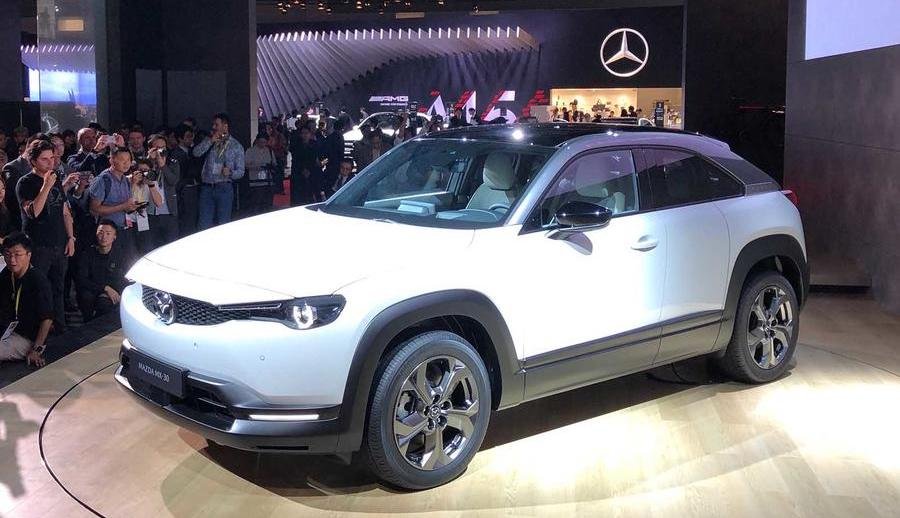First examples of the electric Mazda MX-30, arriving early next year, will be priced from £26,995 including the £3500 plug-in car grant.
There will be 500 versions of the MX-30 First Edition available in the UK, ahead of the standard car arriving later in 2021. The MX-30 First Edition is expected to sit midway in the pricing line-up for the standard MX-30, but a number of factors including exchange rate and a question mark over the plug-in grant's future could affect this.
The MX-30 will shake up the EV market when it arrives, shunning typical characteristics, such as silent motoring and one-pedal driving, that are found in EVs.
Mazda said the car has been developed for drivers who "don't want to sacrifice driving pleasure" when buying an electric car.
Mazda's first electric model will deliver 141bhp and 195lb ft from an electric motor powered by a 35.5kWh battery, offering a range of 130 miles. This is far less than many rivals, such as the 279-mile Hyundai Kona Electric, but Mazda says it exceeds the 31-mile average daily drive of European customers.
Mazda added that it has chosen a smaller battery to achieve better emissions through the entire lifecycle of the car. Its research has found that a 35.5kWH battery produces fewer lifecycle emissions overall than a petrol-powered Mazda3 or an EV using a 95kWh battery (as the Audi E-tron) does.
Christian Schultze, Mazda Europe R&D boss said: "We should not be excessive with battery size. We should consider how much range does a customer really need and how much battery [capacity] can we avoid to reduce CO2 substantially?"
There are no plans for a higher-powered or higher-range flagship MX-30, project manager Takeuchi-san told Autocar.
Mazda has chosen to differentiate the MX-30 from other EVs in a number of driving characteristics. For example, it has less regenerative breaking than many EVs - eschewing the popular one-pedal driving style - and also more progressive acceleration.
Schultze says: "For strong deceleration, we think the brake is better because it moves in the direction of our body. It has the same efficiency as the one-pedal of other EVs but has human advantages."
It has also introduced an artificial sound which is intended to imitate the sound variations heard in an internal combustion-engined car as torque is applied. Mazda told Autocar it is still deciding whether to offer a silent option, which would be controllable by a switch in the car.
The crossover, unveiled at last year's Tokyo motor show, sits on a platform derived from the new architecture used on the Mazda3 and CX-30, but with increased ring structures around the battery and floor in order to achieve a "super stiff and fast-reacting body," said Schultze.
It employs an enhanced version of Mazda's G-Vectoring control system called e-GVC Plus, which "leverages the torque characterisitcs of the electric motor to optimise the front-rear load shift under an even wider range of usage scenarios," said Mazda. The electric motor allows for more minute torque control than an engine, Schultze explained.
The MX-30 is almost the same length as the brand's CX-30 and slightly taller, to accommodate the underfloor battery. It brings back the RX-8's suicide doors which Mazda said "enhances functionality and opens up a wide range of new and creative uses for the MX-30," such as providing easier access for buggies and wheelchairs.
Inside, there is a floating console which includes a new seven-inch touchscreen display. Air conditioning is controlled by the touch panel for the first time in a Mazda, "making operation safe and intuitive," said the brand. Leather is replaced with a vegan alternative, while cork left over from the production of bottle stops is used for the car's storage space and door grips.
The MX-30 is capable of 6.6kW domestic charging and and 50kW rapid charging via a CCS connection, the latter of which will give 80% charge in 30 to 40 minutes, claimed Mazda.
Explaining the MX-30 nomenclature, Mazda said the MX prefix has previously been used on products that "challenge assumptions". For example, the MX-5 was a sporty roadster when this segment had been dismissed by other makers. Mazda's European boss Yasuhiro Aoyama commented: "As with all our products, our designers and engineers had a very clear goal for our first battery electric vehicle. It had to have stand out design, be great to drive, something we believe many manufacturers have forgotten in their rush to launch EV products, and most importantly, make a positive contribution to reducing emission across the entire life cycle of the product".
He added: "Alongside the electrification technologies we are introducing across our range, being a smaller manufacturer we focused all our efforts on creating an electric car that we anticipate will be a second car where the range of our vehicle will meet customers' needs."
Following the launch of the electric MX-30, a range-extender variant will be added to the model line-up, powered by Mazda's famed rotary engine. The Japanese firm's range hasn't featured a rotary-engined road car since the RX-8 went out of production in 2012, but has remained interested in reintroducing the technology to production since. The Mazda RX-Vision Concept, which was shown at the Tokyo motor show in 2015, used such a powertrain.
Talking about the variant, Schultze says: "With the rotary engine range extender, we can recharge during driving and the car becomes long distance. It is a multi-fuel engine, so in the future, we could use with CNG, LPG, hydrogen. We think it's important to have a global view." The model could also offer plug-in hybrid and series hybrid variants.
Mazda UK boss Jeremy Thomson predicts the MX-30 will make up three to five per cent of its overall volume in the first year, betting on EV sales growth beyond the current UK market share of just over one per cent.

